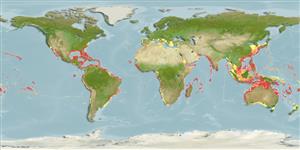Classification / Names
Common names from other countries
Main reference
Size / Weight / Age
Max length : 180 cm TL male/unsexed; (Ref. 26340); common length : 90.0 cm TL male/unsexed; (Ref. 5217); max. published weight: 46.2 kg (Ref. 40637); max. reported age: 6 years (Ref. 96992)
Length at first maturity
Lm 64.6 range ? - ? cm
Environment
Marine; reef-associated; depth range 0 - 150 m (Ref. 9710), usually 2 - 10 m (Ref. 40849)
Climate / Range
Subtropical, preferred 28°C (Ref. 107945); 42°N - 41°S, 95°W - 156°E (Ref. 54429)
Distribution
Western Atlantic: Massachusetts, USA and northern Gulf of Mexico to Rio de Janeiro, Brazil (Ref. 57756). Eastern Atlantic: off Genoa, Italy in the Mediterranean (Ref. 4233) and from Côte d'Ivoire to Angola (Ref. 7097). Throughout the Indo-Pacific (Ref. 37816), but rare or absent in the Persian Gulf (Ref. 3287). Eastern Pacific: mouth of Gulf of California to Ecuador; including the Galapagos Islands (Ref. 9283).
Countries | FAO areas | Ecosystems | Occurrences | Introductions
Short description
IUCN Red List Status (Ref. 115185)
Threat to humans
Reports of ciguatera poisoning (Ref. 30911)
Human uses
Fisheries: highly commercial; gamefish: yes
Tools
Special reports
Download XML
Internet sources
Estimates of some properties based on models
Phylogenetic diversity index
PD50 = 1.0000 many relatives (e.g. carps) 0.5 - 2.0 few relatives (e.g. lungfishes)
Trophic Level
4.3 ±0.0 se; Based on diet studies.
Resilience
Medium, minimum population doubling time 1.4 - 4.4 years (tmax=6; K=0.6 is doubtful)
Vulnerability
Moderate to high vulnerability (51 of 100)
Price category
